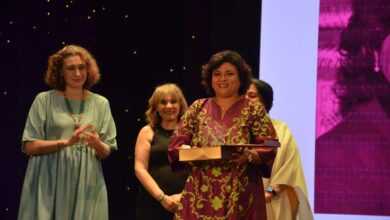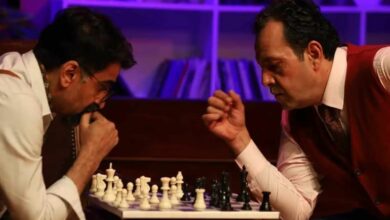
Even before 2011, there had been a growing focus on youth in Egypt; and now with the unfolding revolution, catchy terms like "youth," "participation" and "empowerment" are repeated everywhere. But what is interesting — and important — is how art projects actually try to engage with them. For “Hara TV” (Alley TV), an interactive theater performance that has toured seven governorates, the prospects seem promising.
"Hara TV" is Noon Creative Enterprise’s first project.
According to Nada Sabet, Noon’s director, the group working on "Hara TV" was not interested in preaching, but in engaging with people in a relevant and meaningful way. This approach is particularly clear when it comes to how the performance addresses gender issues and biases. Rather than making the question of women’s participation explicit, the question is simply interwoven into the project of the three actors; two are women, and each play very different characters.
Co-founded in June by Sabet and Sally Sami, the enterprise builds on Sami’s experience in human rights and Sabet’s background in the performing arts to use creative work, and theater in particular, as a tool to develop and encourage active participation in society.
While on tour, "Hara TV" has engaged people from a range of backgrounds. Sami says that among marginalized communities, getting conversations going is not difficult at all.
“People are hungry for it,” she says.
Funny as well as earnest, the first part of the performance is a humorous sketch involving three young people filming a mock TV show entitled “Hara TV.” It begins with two young women meeting over a pile of rubbish. A young man passing by throws some rubbish into the pile, and they engage him in conversation about the rubbish.
Before long the three strangers become friends with a plan. They knock on neighbors’ doors to collect their rubbish. To begin, people respond by slamming doors in their faces or throwing their rubbish at them. But the young people persevere.
This idea of perseverance reappears throughout the play, whether in terms of continuing with their project in the face of hostility, in a conversation about future job prospects, or dealing with a father’s “no.” We watch the strangers become friends; we watch how their project develops. We watch, in other words, how transformative participation can be for both the young man and his new friends.
To begin the discussion, Sabet, in the role of facilitator, asks the audience what the performance was about. The first answers center on recycling. Indeed, Sami says that one of the obstacles they encounter most is that many people think that the play is about promoting recycling. Once the audience latches onto the idea of participation and cooperation, next comes some hot-seating, an important tried and tested method in theater: the actors are asked questions in character.
The conversation can speak intimately to the concerns of the audience, who have become participants in a drama, as it is in large part they who shape the contours of this part of the performance through their questions and comments. So each performance is inevitably different. And no doubt, this conversation at Darb 1718, an art center in Old Cairo that attracts a relatively affluent audience, differs from others.
The content of the play was developed through both research and improvisation within the team of actors and directors. The three characters are university students and perhaps these are not the ideal characters for young people to identify with, given they may never go to university. If, however, the content had been developed through working with the kinds of people the play wants to engage with, it might have taken a different shape.
The name “Hara TV” might imply that the performances would take place in public spaces, but the Hara of the name is better understood as referring to the local sphere where young people can enact change through their actions. At the end of the performances, one audience member suggested that "Hara TV" take place in public spaces such as streets, and was met with a lukewarm response, although the conversations that would take place on the street, drawing in passersby, would be radically different, and arguably make the project more exciting.
The next part of the performance is short: one of the young women complains to her two friends about being sexually harassed on her way to meet them. They offer advice and suggestions, none of which satisfy her. Enter the audience: what would they do?
Before you know it, there is a lively conversation taking place between men and women about sexual harassment. When someone says the woman must have been wearing something inappropriate, another replies that harassing a woman because she is wearing a short skirt is like stealing a car because it was left open. Regardless of what we think about the parallel between a woman and a car, the terrain of the conversation has shifted: the problem is not women but men who think it is their right or entitlement to behave in this way. One person says something about the law, another says the law is ineffective and we need greater awareness. Someone else says not all men are bad, and we can help each other.
In another performance, on the heels of the suggestion that there should be separate facilities for men and women, the specter of a segregated society looms. And then people say this cannot be the solution because they don’t want to live in a segregated society. And so this part of the performance becomes a conversation about what kind of society it is that we want to live in and create.
Notwithstanding the insistence of the team that the issue is not sexual harassment or recycling, but participation, the very fact of including men and women in an open and frank conversation about something that affects people in Egypt of all backgrounds is no small feat.
If the goal of the project is simply to get conversations going about participation, it is undoubtedly a success. But compared with the stated goal of getting people to think about what the obstacles to participation are, and how to overcome them, it might fall short. With the recurrent theme of persistence and perseverance, we might come to believe that the obstacles lie only in ourselves as individuals or in our local communities. If we want to encourage participation of young people from marginalized communities, however, it is important to also deal with the structural obstacles, like access to basic services, that they might face when it comes to participation.
“Hara TV” is showing until 22 December in Fayoum.




